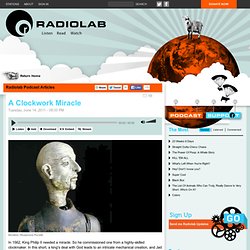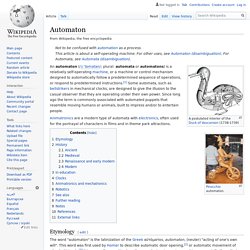

A Clockwork Miracle. In 1562, King Philip II needed a miracle.

So he commissioned one from a highly-skilled clockmaker. In this short, a king's deal with God leads to an intricate mechanical creation, and Jad heads to the Smithsonian to investigate. When the 17-year-old crown prince of Spain, Don Carlos, fell down a set of stairs in 1562, he threw his whole country into a state of uncertainty about the future. Especially his father, King Philip II, who despite being the most powerful man in the world, was helpless in the face of his heir's terrible head wound. Contributor Latif Nasser, a graduate student in the History of Science Department at Harvard, explains that when none of the leading remedies of the day--bleeding, blistering, purging, or drilling--helped, the king enlisted the help of a relic...the corpse of a local holy man who had died 100 years earlier.
Carlos, Prince of Asturias. Several of the Carlist pretenders to the Spanish throne were also known as Don Carlos.

Life[edit] Carlos of Austria, Infante of Spain, was born at Valladolid, and his mother died a month after his birth. The young Infante Carlos was delicate and deformed. He grew up proud and willful and, as a young adult, began to show signs of mental instability. Many of his physical and psychological afflictions may have stemmed from the inbreeding common to the House of Habsburg and the royal houses of Portugal and Spain.
Carlos was recognized in 1560 as the heir-apparent to the Castilian throne, and three years later as heir-apparent to the Crown of Aragon as well. In 1562 Carlos fell down a flight of stairs, which caused serious head injuries. In January 1568 Don Carlos was arrested and placed in solitary confinement on his father's orders. Carlos left an unfavourable impression on some foreign ambassadors. Legend[edit] Ancestors[edit] Notes[edit] References[edit] Further reading[edit] Philip II of Spain. A Clockwork Miracle - Slideshow. Automaton. A self-operating machine Animatronics are a modern type of automata with electronics, often used for the portrayal of characters in films and in theme park attractions.

Etymology[edit] The word "automaton" is the latinization of the Greek αὐτόματον, automaton, (neuter) "acting of one's own will". This word was first used by Homer to describe automatic door opening,[2] or automatic movement of wheeled tripods.[3] It is more often used to describe non-electronic moving machines, especially those that have been made to resemble human or animal actions, such as the jacks on old public striking clocks, or the cuckoo and any other animated figures on a cuckoo clock. History[edit] Ancient[edit] The automata in the Hellenistic world were intended as tools, toys, religious idols, or prototypes for demonstrating basic scientific principles. The Antikythera mechanism from 150–100 BC was designed to calculate the positions of astronomical objects.
The animated figures stand Adorning every public street. Automaton figure of a monk, South Germany or Spain, c. 1560.